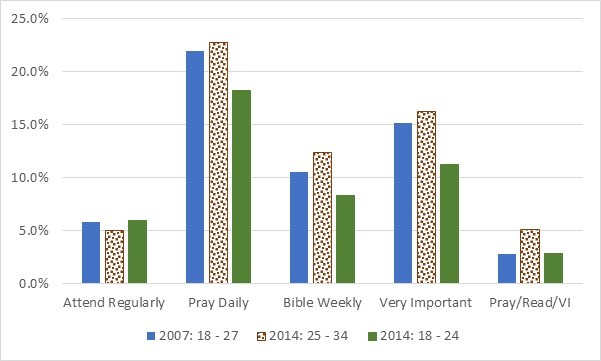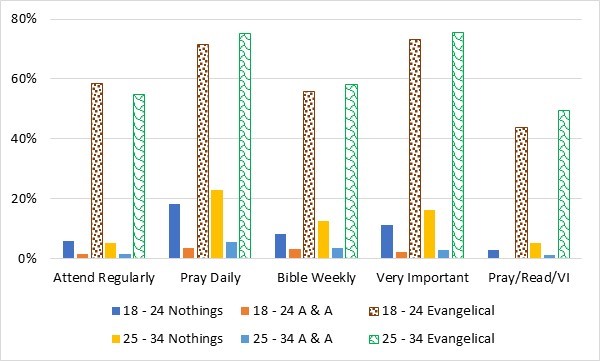Steve Cable determines that ‘Nothing in Particulars’ are not actually practicing Christians who just don’t want to affiliate with a particular denomination.
Earlier we examined the significant increase in Nones (those who said their religious affiliation was atheist, agnostic or nothing in particular), which grew from 25% of young adults in 2007 to over 35% of young adults in 2014 according to the U.S. Religious Landscape Survey taken by Pew Research.{1} In this post, we will examine the level of involvement in religious practices that these Nones, and particularly the Nothing in Particulars, reported in response to the survey questions. We will try to answer the question: “Are these Nothing in Particulars actually Christians who do not feel comfortable announcing an affiliation with a particular religious group?”
 First, let’s consider the religious practices of the Nothing in Particulars. In Figure 1, we see their commitment to some common behaviors of nominal and committed Christians. The actual questions are:
First, let’s consider the religious practices of the Nothing in Particulars. In Figure 1, we see their commitment to some common behaviors of nominal and committed Christians. The actual questions are:
- Aside from weddings and funerals, how often do you attend religious services? [Monthly or more]
- People practice their religion in different ways. Outside of attending religious services, do you pray? [At least once per day]
- Read scripture outside of religious services [At least weekly]
- How important is religion in your life? [Very important]
- Pray daily and read scripture weekly and consider religion very important in your life.
As shown, the figure looks at the answers to these questions for three different groups:
- Those responding in 2007 who were 18 through 27 years of age
- Those responding in 2014 who were 25 through 34 years of age (the age range corresponding to those 18 through 27 in 2007)
- Those responding in 2014 who were 18 through 24 years of age
As you can see, about one in five pray at least daily, about one in ten read the Bible at least once a week, about one in twenty attend church at least once a month. And only about three out of one hundred pray, read the Bible and consider religion to be a very important part of their life.
Note that the corresponding age groups across the two survey dates have roughly the same percentage of respondents who participate in these practices, but the youngest group lags their elders in praying, Bible reading, and attitude toward religion.
 How do these levels relate to the responses from Evangelicals on the one hand and from Atheists and Agnostics on the other hand? Figure 2 gives us the answer to this question.
How do these levels relate to the responses from Evangelicals on the one hand and from Atheists and Agnostics on the other hand? Figure 2 gives us the answer to this question.
First let’s orient ourselves to the data. The first and fourth column of each group correspond to the second and third column of each group in Figure 1, i.e. 18–24s and 25–34s from 2014. The second and fifth column of each group are the responses from Atheists and Agnostics. As you can see, they are lower than those for the Nothing in Particulars in every category. But more importantly, those results for Evangelical young adults in both age categories (columns three and six) are much, much higher than those for Nothing in Particulars and Atheists and Agnostics.
For example, looking at reading the Bible at least once a week, we find about one in ten Nothing in Particulars, about one in thirty-five Atheists and Agnostics, and almost six out of ten Evangelicals.
Looking at the combination of prayer, Bible reading, and considering religion a very important part of life, we find about one out of twenty-five Nothing in Particulars, about one in one hundred Atheists and Agnostics, and almost five out of ten Evangelicals.
Clearly in this area of religious practice the Nothing in Particulars appear to be much closer in their practice to those who profess Atheism or Agnosticism than those who are Evangelical.
The data clearly does not support the notion that the Nothing in Particulars are actually practicing Christians who just do not want to affiliate with a particular denomination. In fact, the vast majority of Nothing in Particulars have no regular activity associated with worshipping God. Perhaps they believe in Christianity even though they don’t attempt to practice it. We will consider that possibility in our next blog post.
Note
{1} The U.S. Religious Landscape Survey 2007 and 2014, Pew Forum on Religion & Public Life (a project of The Pew Research Center). The Pew Research Center bears no responsibility for the analyses or interpretations of the data presented here. The data were downloaded from the Association of Religion Data Archives, www.TheARDA.com, and were collected by the Pew Research Center.